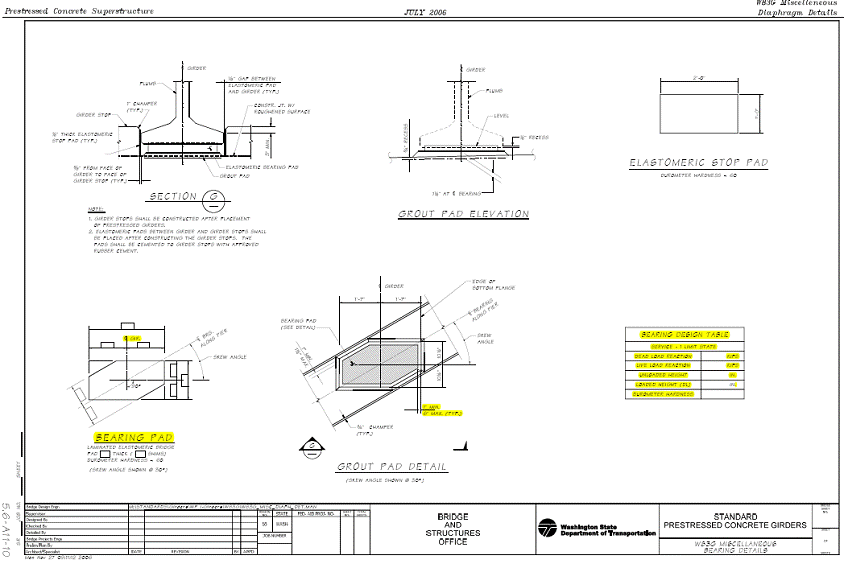
Design Memorandum
TO: All Design Section Staff
FROM: Bijan Khaleghi
DATE: November 28, 2006
SUBJECT: Elastomeric Bearing for Prestressed Girders
This design memorandum is to provide guidance for the required width of the elastomeric bearing pad for precast prestressed concrete girders and slabs.
1. For prestressed concrete wide flange girders (WF42G, WF50G, WF58G, WF74G, W83G, and W95G), the edge of the bearing pad shall be set from 1” minimum to 6” maximum from the edge of the bottom flange.
2. For prestressed concrete I-girders, bulb tee girders, and deck bulb-tee girders, the edge of the bearing pad shall be set at 1” from the edge of the bottom flange.
3. For all prestressed concrete tub girders, the edge of the bearing shall be set at 1” from the edge of the bottom slab. Bearing pads for prestressed concrete tub girders shall be placed close to the centerline of each web.
4. For precast prestressed slabs, the edge of the bearing shall be set at 1” from the edge of slab. Two bearing pads and corresponding grout pads are required for each end of precast prestressed slabs. The need for steel shims shall be investigated in bearing design.
The following table summarizing the bearing design loads at service-I limit state shall be included in the Plans for future bearing repair and replacement.

Prestressed concrete girders standard drawings will be modified to reflect the above modifications.
Background
The current practice for sizing elastomeric bearing pads requires extending the pads to 1” from the edge of bottom flange for all prestressed concrete girders. This practice results in difficulties in designing and sizing of elastomeric bearing pads for wide flange I girders. The width of bottom flange for prestressed concrete wide flange I girders is 52 percent wider than the other prestressed concrete girders. Extra wide bearing pads for wide flange I girders may require reducing the length of the pad to meet the rotational requirements about the longitudinal axis. Reducing the length of the pad results in a higher compressive stress and smaller shape factor, making it easier to meet the rotational requirements. However, the higher compressive stress associated with the decreased length of the pad makes it more difficult to meet the compressive stress requirements. This design memorandum allows reducing the width of bearing pads for wide flange I girders to meet the bearing design requirements.
The addition of bearing design table in the Plans is necessary for future reference for bearing replacement.
If you have any questions regarding this issue, please contact Ralph Dornsife at 705-7199 or Bijan Khaleghi at 705-7181.
cc: Mohammad Sheikhizadeh, Bridge Construction - 47354
F. Posner, Bridge and Structures – 47340
|


